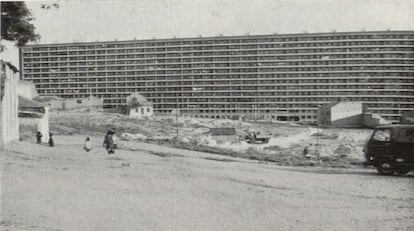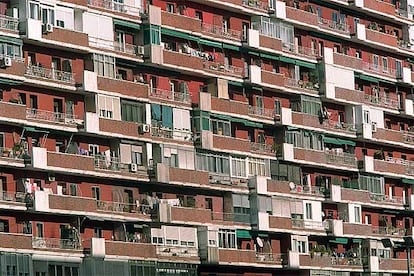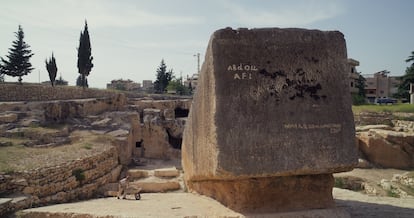Two hundred years of cement: The story of the building material that changed the world
Portland cement, registered 200 years ago by a bricklayer who named it after his native island, has come to symbolize capitalist logic. We are at a paradigm shift, but lack new material for this new constructive culture

Portland cement is turning 200 years old. It was registered in 1824 by Joseph Aspdin, a bricklayer who named it that way because its characteristic gray color reminded him of his native land, the English island of the same name, in Dorset. It is a binder that, mixed with sand, water and steel fibers, forms concrete. This artificial, cheap and easy-to-mold material is what defines our everyday landscape.
Yes, we often talk about nebulous intelligences and digital worlds, but for the moment we are still firmly immersed in the Age of Cement. It is present in homes, schools, hospitals and shopping malls, on highways, in the subway, in train stations and at airports. It is the material with which the dreams (and nightmares) of modern civilization have been built, although in historical terms it was born just a moment ago.
“Cement is the second most widely used product by humans after water. That is why it is important to be familiar with it. We see roads and buildings and we think that they have always been there, but that is not the case,” explains Francisca Puertas Maroto, a research professor at the Eduardo Torroja Institute of Construction Sciences, of Spain’s National Research Council (CSIC).

“The passion for building is something inherent to civilized beings,” says Valentín Alejándrez, director of the CINTER publishing house. Over the centuries, this drive to build—sometimes amazingly useful and productive, sometimes crazy—has gone hand in hand with a variety of materials such as clay mixed with straw, raw or carved stones, clay bricks dried in the sun, cement and iron, until humans reached concrete in its various forms, including reinforced concrete, prestressed concrete and the new fiber-reinforced concrete.
From the Roman roads to cheap housing
The first great engineers were the Romans, and the expansion of their empire led them “to build roads, bridges, aqueducts to supply water to large populations, dams, temples, government buildings, coliseums for the entertainment of the masses,” as Alejándrez notes.
Centuries later the industrial revolution brought the need for giant spaces to process and store products. “In a short time the territory was infrastructured, so to speak. The increasing use of railways to move material, goods and people led to much larger bridges, tunnels, and commercial ports. And since the material had certain limitations, research was carried out to improve it until we found Portland cement,” explains João Mascarenhas-Mateus, author of Changing Cultures: European Perspectives on the History of Portland Cement and Reinforced Concrete, 19th and 20th Centuries.
With the rapid expansion of the Portland variety came the cementization of the world, an unprecedented cultural landscape fueled by new economic, political and social structures that, in turn, created new studies, professions and legislation. In Spain, for decades, being an architect was the best job; buying and selling land to build was a source of wealth and a safe business, and corruption in the field of construction was allied with local, provincial and national politics. In the face of successive housing crises, apartments made with the cheapest material for those who earn little or almost nothing even became an object of barter. The political scientist Julio Embid explained it in his 2016 book Children of Concrete. While walking through the Madrid area of Usera, he found an ad that said “I will trade an apartment at the far end of Antonio López street in exchange for stable employment.”

Raising the tallest skyscraper—or living in it—has been the wet dream of quite a few men, all over the world. It seems like an outdated aspiration yet it remains real, for example, in Shanghai: since 2000 this Asian metropolis has added more skyscrapers than all those that have existed in New York City since the Flatiron building was erected in 1902.
But nothing lasts forever. “We have over-cemented our territory, our nature, our landscape,” stresses Mascarenhas-Mateus, a researcher at the Center for Architecture, Urban Planning and Design at the University of Lisbon. “The culture of construction changes when the dimension, context and objectives of a society are transformed. And now we are at a turning point.”
Brakes on the machine
There are more and more voices denouncing the abuse of this material due to its role in global warming. Cement production alone represents up to 7% of global CO2 emissions, which is “more than all the emissions of the European Union or India, just behind those of China and the United States,” said Valérie Masson-Delmotte, a key collaborator of the United Nations Intergovernmental Panel on Climate Change, in statements to Agence France Presse. According to the 2015 Paris Climate Agreement, the global concrete industry must reduce its emissions by 16% by 2030 and 100% by 2050.

“We must stop the catastrophe before it is too late,” said Viktor Kossakovsky, a Russian film director, during the presentation of Architecton last April in Barcelona. In his documentary, Kossakovsky denounces the abuse of unsustainable construction practices, aiming to re-learn from the works of other centuries, which were more habitable and more respectful of the environment.
“Concrete embodies capitalist logic. It is the ‘concrete’ side of commercial abstraction. Like it, it cancels out all differences and is more or less always the same. Produced industrially and in astronomical quantities, with disastrous environmental and health consequences, it has extended its dominance throughout the world, murdering traditional architecture and homogenizing all places with its presence,” writes Anselm Jappé in his 2020 book Béton – Arme de construction massive du capitalisme [Concrete. Capitalism’s Weapon of Mass Construction].
It is like a large machine that is going too fast: it must be stopped and redirected to make it less destructive. “We are at the beginning of a great transformation. We are moving towards a paradigm shift, but we lack new material for this new constructive culture,” warns Mascarenhas-Mateus.
The concept of construction is being rethought, promoting the circular economy, recycling, the rehabilitation of buildings, and also by investigating possible ways to decarbonize materials. “We must reduce the high energy consumption and the carbon footprint associated with the production of construction materials and construction in general,” says Puertas Maroto, an author who has written on the subject.
“It is necessary for building regulations to incorporate the use of these materials, not in a general way, but in cases where a change in the technical characteristics of the concrete is acceptable,” says Alejándrez.
What was considered modern 200 years ago, then, has become outdated. It’s like those infinite cement towers, very new in appearance yet already obsolete. Like the Liebian skyscraper in Guiyang (China), which includes the world’s tallest artificial waterfall falling from the top floor. A waterfall in a building: a crazy architectural spectacle 108 meters high that costs €76 per hour in electricity alone.
Sign up for our weekly newsletter to get more English-language news coverage from EL PAÍS USA Edition
Tu suscripción se está usando en otro dispositivo
¿Quieres añadir otro usuario a tu suscripción?
Si continúas leyendo en este dispositivo, no se podrá leer en el otro.
FlechaTu suscripción se está usando en otro dispositivo y solo puedes acceder a EL PAÍS desde un dispositivo a la vez.
Si quieres compartir tu cuenta, cambia tu suscripción a la modalidad Premium, así podrás añadir otro usuario. Cada uno accederá con su propia cuenta de email, lo que os permitirá personalizar vuestra experiencia en EL PAÍS.
¿Tienes una suscripción de empresa? Accede aquí para contratar más cuentas.
En el caso de no saber quién está usando tu cuenta, te recomendamos cambiar tu contraseña aquí.
Si decides continuar compartiendo tu cuenta, este mensaje se mostrará en tu dispositivo y en el de la otra persona que está usando tu cuenta de forma indefinida, afectando a tu experiencia de lectura. Puedes consultar aquí los términos y condiciones de la suscripción digital.
More information
Archived In
Últimas noticias
Welcome to the post-religion era: The idea of Christianity as the absolute truth has become obsolete
‘I thought you would like it’: The risky sexual practice popularized by TV shows and TikTok
The digitalization of tourism: ‘They promise experiences and gave us the worst possible one’
Mexican peso defies uncertainty with forecasts of a new period of stability in 2026
Most viewed
- Sinaloa Cartel war is taking its toll on Los Chapitos
- Oona Chaplin: ‘I told James Cameron that I was living in a treehouse and starting a permaculture project with a friend’
- Reinhard Genzel, Nobel laureate in physics: ‘One-minute videos will never give you the truth’
- Why the price of coffee has skyrocketed: from Brazilian plantations to specialty coffee houses
- Silver prices are going crazy: This is what’s fueling the rally











































